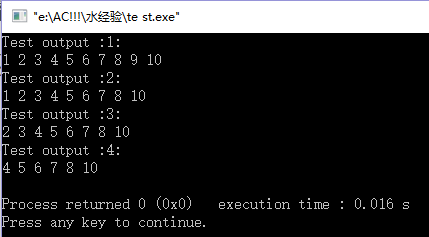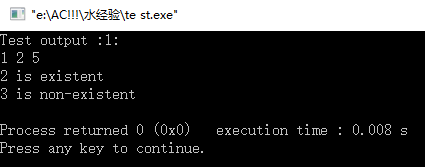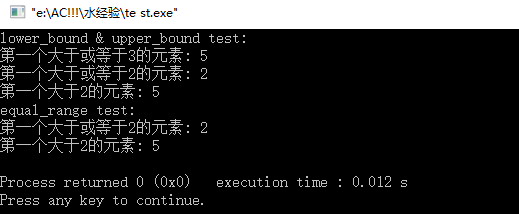set是STL中一种标准关联容器。它底层使用平衡的搜索树——红黑树实现,插入删除操作时仅仅需要指针操作节点即可完成,不涉及到内存移动和拷贝,所以效率比较高。set,顾名思义是“集合”的意思,在set中元素都是唯一的,而且默认情况下会对元素自动进行升序排列,支持集合的交(set_intersection),差(set_difference) 并(set_union),对称差(set_symmetric_difference) 等一些集合上的操作,如果需要集合中的元素允许重复那么可以使用multiset。
1.set容器的常用操作
使用时注意包含头文件<set> std::set and std::multiset associative containers
s.begin() 返回set容器的第一个元素
s.end() 返回set容器的最后一个元素
s.clear() 删除set容器中的所有的元素
s.empty() 判断set容器是否为空
s.insert() 插入一个元素
s.erase() 删除一个元素
s.size() 返回当前set容器中的元素个数
set模板原型://Key为元素(键值)类型
template <class Key, class Compare=less<Key>, class Alloc=STL_DEFAULT_ALLOCATOR(Key) >2.set容器的创建
#include <iostream>
#include <set>
#include <functional>
using namespace std;
set<int> s;
int main(){
set<int > seta; //默认是小于比较器less<int>的set
set<int, greater<int> > setb; //创建一个带大于比较器的set,需包含头文件functional
int a[5] = {1,2,3,4,5};
set<int > setc(a,a+5); //数组a初始化一个set;
set<int > setd(setc.begin(),setc.end()); //setc初始化一个set
//上述两例均为区间初始化
set<int > sete(setd); //拷贝构造创建set
return 0;
}
3.set容器的增删改查
①插入
#include <iostream>
#include <set>
using namespace std;
set<int >s;
void setprint(int cnt){
cout << "Test output :" << cnt << ":" << endl;
for(set<int>::iterator it = s.begin(); it!= s.end(); it++)
cout << *it << " ";
puts("");
return ;
}
int main(){
int cnt = 1;
s.insert(1);
s.insert(2);
s.insert(5);
setprint(cnt++);
s.insert(2); //set只允许用一个值出现一次,要插入相同元素请用multiset
setprint(cnt++);
int a[4] = {11,12,13,14};
s.insert(a,a+4); //将区间[a, a+4]里的元素插入容器
setprint(cnt++);
return 0;
}
②删除
s.erase() 删除一个元素
s.clear() 删除set容器中的所有的元素
#include <iostream>
#include <set>
using namespace std;
set<int >s;
void setprint(int cnt){
cout << "Test output :" << cnt << ":" << endl;
for(set<int>::iterator it = s.begin(); it!= s.end(); it++)
cout << *it << " ";
puts("");
return ;
}
int main(){
int cnt = 1;
for(int i = 1; i < 11; i++){
s.insert(i);
}
setprint(cnt++);
s.erase(9); //根据元素删除
setprint(cnt++);
set<int>::iterator ita = s.begin();
set<int>::iterator itb = s.begin();
s.erase(ita); //删除迭代器指向位置的元素
setprint(cnt++);
ita = s.begin();
itb = s.begin();
itb++;itb++;
s.erase(ita,itb); //删除区间[ita,itb)的元素
setprint(cnt);
s.clear();
return 0;
}
③修改
不能直接修改容器内数据,所以只能删除某元素再插入要修改的数值。
④查找
s.find() 查找一个元素,如果容器中不存在该元素,返回值等于s.end()
#include <iostream>
#include <set>
using namespace std;
set<int >s;
void setprint(int cnt){
cout << "Test output :" << cnt << ":" << endl;
for(set<int>::iterator it = s.begin(); it!= s.end(); it++)
cout << *it << " ";
puts("");
return ;
}
int main(){
int cnt = 1;
s.insert(1);
s.insert(2);
s.insert(5);
setprint(cnt++);
if(s.find(2) != s.end())
cout << "2 is existent" << endl;
else
cout << "2 is non-existent" << endl;
if(s.find(3) == s.end())
cout << "3 is non-existent" << endl;
else
cout << "2 is existent" << endl;
return 0;
}
4.set的其他常用操作
①
s.lower_bound() 返回第一个大于或等于给定关键值的元素
s.upper_bound() 返回第一个大于给定关键值的元素
s.equal_range() 返回一对定位器,分别表示 第一个大于或等于给定关键值的元素 和 第一个大于给定关键值
的元素,这个返回值是一个pair类型,如果这一对定位器中哪个返回失败,就会等于
s.end()
#include <iostream>
#include <set>
using namespace std;
int main(){
set<int> s;
s.insert(1);
s.insert(2);
s.insert(5);
cout << "lower_bound & upper_bound test:" << endl;
cout << "第一个大于或等于3的元素: " << *s.lower_bound(3) << endl;
cout << "第一个大于或等于2的元素: " <<*s.lower_bound(2) << endl;
cout << "第一个大于2的元素: " <<*s.upper_bound(2) << endl;
cout << "equal_range test:" << endl;
cout << "第一个大于或等于2的元素: " << *s.equal_range(2).first << endl;
cout << "第一个大于2的元素: " << *s.equal_range(2).second << endl;
return 0;
}
②判断元素是否在set中 & 判断set是否为空
#include <iostream>
#include <set>
#include <functional>
using namespace std;
int main(){
set<int > s;
if(s.empty()) cout << "容器为空" << endl;
s.insert(1);
if(!s.empty()) cout << "容器不为空" << endl;
if(s.count(1)) cout << "1在容器中" << endl;
if(!s.count(2)) cout << "2不在容器中" << endl;
return 0;
}③自定义比较函数
#include <iostream>
#include <set>
#include <functional>
using namespace std;
struct cmp{
bool operator () (const int &a, const int &b){
return a > b;
}
};
set<int, cmp>s; //自定义排序函数构造set
void setprint(int cnt){
cout << "Test output :" << cnt << ":" << endl;
for(set<int,cmp>::iterator it = s.begin(); it!= s.end(); it++)
cout << *it << " ";
puts("");
return ;
}
int main(){
s.insert(1);
s.insert(2);
s.insert(6);
setprint(1);
return 0;
}以上就是刷题必备的set用法,熟练掌握,要用时别用错就成。
至于求并、交、差、对称差等操作,暂不细说,使用时要包含头文件”algorithm”。
此外还有unordered_set和unordered_multiset,为set和multiset的无序版,使用时要包含头文件”unordered_set”。




























 1507
1507











 被折叠的 条评论
为什么被折叠?
被折叠的 条评论
为什么被折叠?








